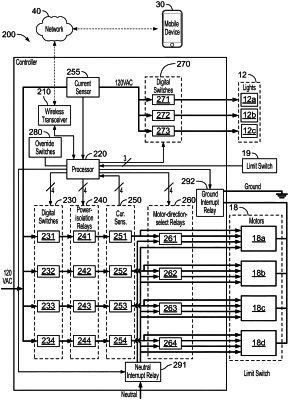| CPC B63C 3/06 (2013.01) [E02C 5/00 (2013.01); H02P 1/40 (2013.01)] | 20 Claims |

|
1. A control system for controlling at least one motor on a boat lift, the control system comprising:
a processor configured to output a first digital-relay control signal and a first power-isolation relay control signal;
a first digital relay including a control input, a high-voltage input, and a high-voltage output, wherein the control input of the first digital relay is configured to receive the first digital-relay control signal from the processor, wherein the high-voltage input of the first digital relay is configured to receive high voltage, wherein the high-voltage output of the first digital relay is configured to selectively output the high voltage based on a state of the first digital-relay control signal;
a first power-isolation relay configured to selectively isolate the high voltage from a first motor, wherein the first power-isolation relay includes a control input, a high-voltage input, and a high-voltage output, wherein the control input of the first power-isolation relay is configured to receive the first power-isolation relay control signal from the processor, wherein the high-voltage input of the first power-isolation relay is configured to receive the high-voltage from the output of the first switching component, wherein the high-voltage output of the first power-isolation relay is configured to selectively supply the high voltage to the first motor based on a state of the first power-isolation relay control signal;
wherein the processor is configured to cause the first motor to be energized by:
changing a state of the first power-isolation relay control signal to actuate the first power-isolation relay, such that the high-voltage input of the first power-isolation relay becomes electrically connected to the high-voltage output of the first power-isolation relay, and
after said changing the state of the first power-isolation relay control signal to actuate the first power-isolation relay, changing a state of the first digital-relay control signal to activate the first digital relay, such that the high-voltage input of the first digital relay becomes electrically connected to the high-voltage output of the first power-isolation relay; and
wherein the processor is configured to cause the first motor to be de-energized by:
changing a state of the first digital-relay control signal to deactivate the first digital relay, such that the high-voltage input of the first digital relay becomes electrically disconnected to the high-voltage output of the first digital relay, and
after said changing the state of the first digital-relay control signal to deactivate the first digital relay, changing a state of the first power-isolation relay control signal to de-actuate the first power-isolation relay, such that the high-voltage input of the first power-isolation relay becomes electrically disconnected from the high-voltage output of the first power-isolation relay.
|